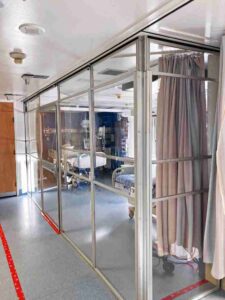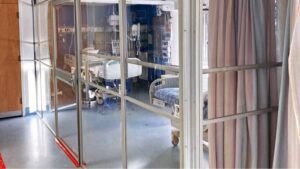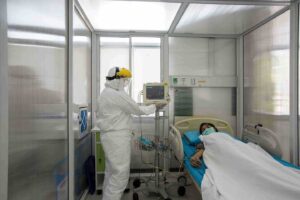How to Control Cross-Infection in Hospitals: Modular Containment
Hospital-Acquired Infections (HAIs) are a significant concern, affecting one in 25 patients daily in U.S. hospitals. HAIs not only escalate healthcare costs but also lead to severe health consequences, including fatalities. Let’s tackle the simple ways and recommendations provided by The World Health Organization (WHO) on how to control cross-infection in hospitals.
Through this article, we will discuss some of the standard control guidelines provided by WHO to prevent cross-infection in hospitals and highlight the significance of each step. Additionally, we’ll explore innovative solutions, such as temporary wall systems, designed to meet ICRA Class V standards. These ensure uninterrupted healthcare operations during renovations and enhance infection control by containing dust and airborne particles.
How to Control Cross Infection in Hospitals
To safeguard patients and healthcare staff, following simple guidelines is paramount in preventing Hospital-Acquired Infections (HAIs). Here are ways on how to control cross infection in hospitals:
Keep Hands Clean
Proper hand washing is crucial for reducing HAIs. Encourage everyone in the facility, including staff and visitors, to wash hands thoroughly before eating, drinking, after using the bathroom, and after any interaction with a patient. Using soap and water for at least 20 seconds is considered the most effective handwashing practice.
Use Proper Protective Gear
Provide and use isolation-appropriate protective equipment, including waterproof gowns, gloves, shoe covers, face shields, and masks. Ensure this gear is readily available, especially when dealing with areas that have patients with contagious illnesses.
Using Gloves
While working in a hospital, workers should wear gloves while setting up walls whenever there’s a possibility of contact with blood or bodily fluids.
Maintain Clean Surfaces
Thoroughly clean the areas in the facility with a bleach-containing cleanser between jobs. This helps prevent accidental transmission of infections.
Ensure an Airtight Environment for Infection Control
When designing new or renovated hospital facilities, prioritize infection control by implementing temporary wall systems that meet ICRA Class IV standards to fully isolate dust and airborne particles.
What is the Most Common Route of Cross Infection Transmission?
There are many routes of cross infection transmission, but the most common is direct contact transmission. Let’s explore each of the routes of cross infection transmission below:
Direct Contact Transmission
Transmission through direct contact occurs when an individual comes into direct physical contact with the tissues or fluids of an infected person. Microorganisms can be transferred and enter through mucous membranes (such as eyes or mouth), open wounds, or damaged skin. Inoculation may also happen through bites or scratches.
Aerosol (Airborne) Transmission
Aerosol transmission involves the movement of pathogens through very small particles or droplet nuclei, which can be inhaled by a vulnerable host or settle on mucous membranes or surfaces. This transmission method occurs through everyday actions like breathing, coughing, sneezing, or talking by an infected person and during various medical procedures like suctioning, bronchoscopy, dentistry, and inhalation anesthesia.
Oral (Ingestion) Transmission
Ingesting pathogenic organisms can occur through the consumption of contaminated food or water. Common sources of environmental contamination include exudates, feces, urine, or saliva.
Fomite Transmission
In fomite transmission, inanimate objects contaminated by an infected individual can transmit pathogens upon contact with a susceptible animal or human. Examples of fomites include various items such as examination tables, cages, kennels, medical equipment, environmental surfaces, and clothing.
Vector-Borne Transmission
Vectors are living organisms that transfer pathogenic microorganisms to other animals or areas, comprising arthropod vectors like mosquitoes, fleas, ticks, rodents, and other vermin. In regions with a year-round presence of these pests, vector-borne transmission becomes a significant pathway, especially when an infested patient brings them into practice.
Zoonotic Transmission
It’s essential to be aware that numerous animal diseases are zoonotic, presenting a risk to both the healthcare team and clients. These agents can be transmitted through the same five routes described earlier. Zoonotic pathogens such as Microsporum, Leptospira, Campylobacter, and Bartonella are noteworthy examples.
Control Cross-Infection With Modular Containment Solutions
Utilizing anterooms and cleanrooms, hospitals can effectively control cross-contamination and infection. Learn more about the superior infection control benefits of our temporary wall systems. Contact us now for a personalized quote to enhance the safety of your healthcare environment with our airtight containment solutions.
More from Healthcare

Understanding the Difference Between ICRA and ISO Classifications in Modular Wall Systems
Read Article
